|
|
Mayan Coronas
Unlucky for some |
13.0.7.5.19
| |
Today was Friday the 13th, a day steeped in superstition, (although I understand that for Spanish speaking countries it's Tuesday the 13th that's the unlucky day, so we should be OK today!).
However for the Maya they have several inauspicious dates. But they do have a completely different calendar, in fact more than one calendar. There's the long count, a sequence of numbers from a mythical dawn of life and the end of which got everyone predicting the apocalypse on 21st December 2012. But the numbers kept rolling on as did the planet. Today is 13.0.7.5.19.
Then there's the Tzolk'in calendar which have names for each of the 13 days of the Mayan "week" accompanied by another sequence of 20 numbers, giving a 260 day calendar. Today is 4 Kawoq (or Kawak dependent on which Mayan language is spoken, Quiche in Guatemala or Yucaten in Mexico or one of the several other dialects in between. Kawoq, the day of thunder.
Then there's another sequence known as the Haab', which is effectively an 18 "month" calendar of 20 days each. Today is 7 Kumk'u. There are 5 extra days called Wayeb to make up the 365 days of earth's orbit around the sun. These are considered the most unlucky of days!
And finally there was another sequence, the Lord of the Night, that represented one of nine deities of the underworld, whose names have been forgotten. No wonder the Mayan's had day keepers or time lords keeping count. It's just so complex!
After last night's fire water the palet was a bit parched this morning. The filtered water urn downstairs was much appreciated. Rehydated and feeling closer to normal than before our thoughts turned to breakfast.
Gabo had recommended Fernando's. It was on the same street as our hotel, 7a Avenida Norte, literally a block away. We had walked past it yesterday and thought it was nothing more than a little coffee shop but he explained that inside it opened out into a lovely courtyard.
True enough, once we stepped inside, stroked the resident cat asleep on the counter, performed a cursory browse of the little shop selling Fernando's own house roasted coffee, we stepped into a lovely open courtyard.
It was so peaceful here.
Breakfast began with a fruit juice. My glass of Antigua Cool pineapple and orange was mind-blowing. It was so delicious. We also had a coffee which as expected was immeasurably good.
Breakfast for me was another take on the typical "full Gutatemalan". Yesterday's Chiapa may have been more refined but this morning's Tipico was a plate full. Plenty of black beans (not refried), fried eggs, fried plantain and an extra portion of fried tomatoes for good measure. All served with a few tortillas. Other than the tomatoes there was nothing on that plate that Julie liked so she ordered a croissant.
Having eaten we returned to our hotel and waited to join up with the rest of the group where Gabo would lead us on an "orientation tour of Antigua".
Sure enough at 10am most of us were gathered ready. There were a few absentees. There had been talk last night of some going on a day trip to Lake Atitlan, which I would have really liked but it was a 6:30am start and a 12 hour excursion. With an extremely early start scheduled for tomorrow we decided to have another chill out day in Antigua.

We all followed Gabo down to Parque La Merced where some sort of festival was in the process of starting. A statue of Christ carrying the cross was lifted on the shoulders of quite young float bearers. In fact there were a lot of children around. Many were dressed up as characters from the crucifixion scene. We had a mini cross carrying Christ, a few disciples, a couple of Virgin Marys and a spear wiedling Roman soldier.

Good Friday was still four weeks away but Easter is the highlight of the Antiguan calendar. Their Semana Santa celebrations reputedly rivals anything Seville can offer. Gabo asked someone what was going on here today and apparently it was a dress rehearsal for the chidren's procession that leaves from here on the Wednesday of the Holy Week.
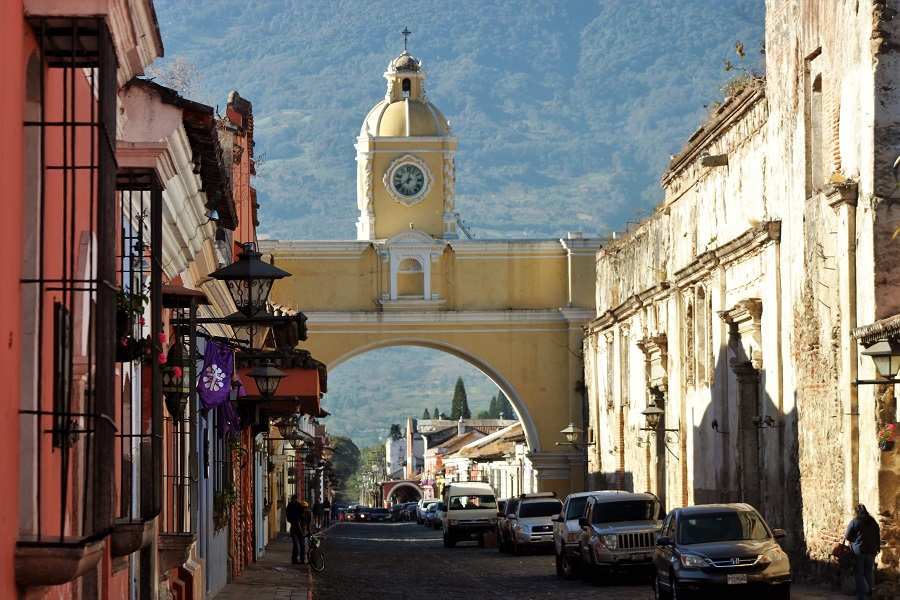
We continued our walk, heading down towards the Santa Catalina Arch. Gabo imparted with a few sketchy dates and figures but whilst his facts were a little vague you couldn't fault his enthusiasm about the magic of Antigua's colonial architecture.
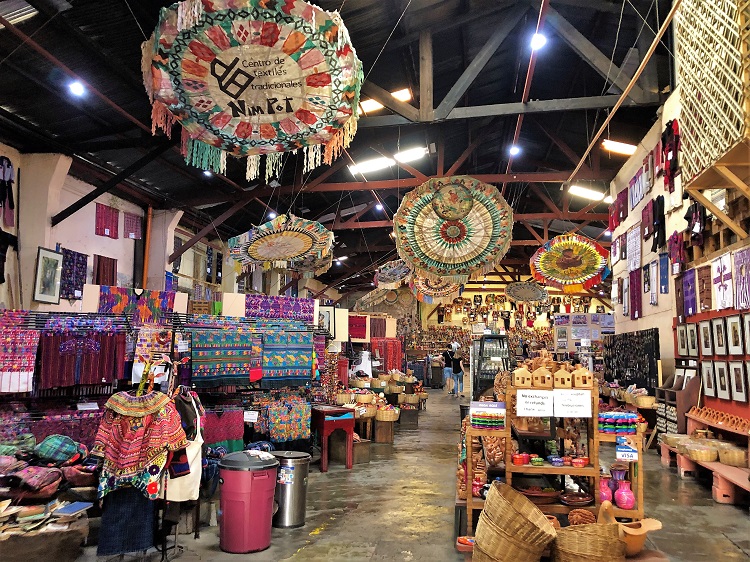
Before reaching the arch we came to a local crafts store called Nim Po't. Gabo gave us the option to have a look inside so we all did.
It was a huge space filled with textiles and handicrafts from all over the region. The colourful fabrics were fascinating. Each town had its own unique pattern, Chichicastenango, San Antonio Aguas Calietes, San Pedro Sacatepequez. Then Huipiles (or Guipiles) traditional dresses and blouses were cut from these incredibly vibrant cloth.
Julie and I felt we needed to buy something at least. There were some great ceremonial masks at the far end but we didn't want anything bulky to carry for the rest of the trip. We almost bought some "worry dolls" but even they seemed too big for our rucksack. In the end we picked up a brightly coloured scarf.
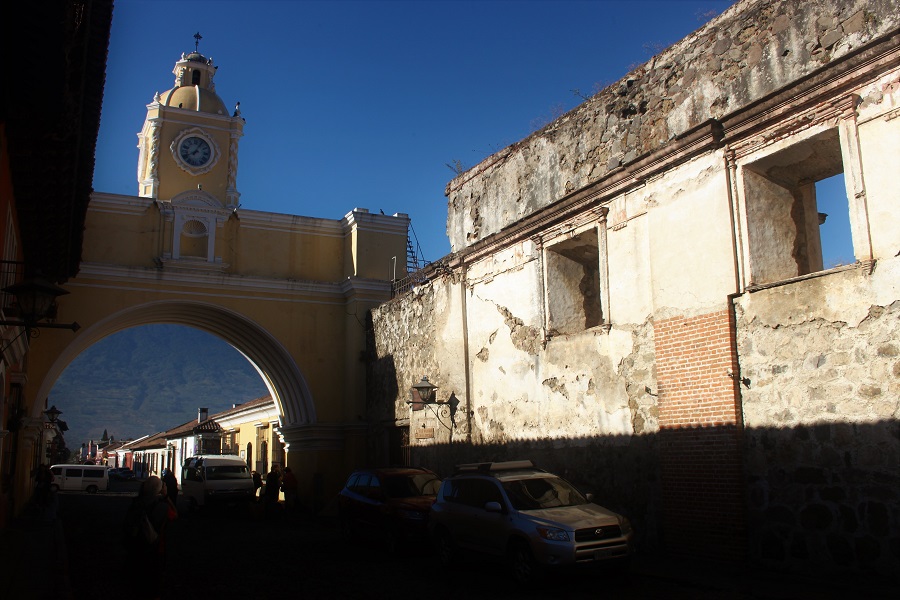
Whilst we waited outside for all the group to finish buying souvenirs we stood and marvelled at the Santa Catalina arch once more, with the ruins of another abandoned church across the street.
Through the arch the original Convent of Santa Catalina had been restored, even painted in the same canary yellow as the arch and is now one of the city's top hotels. In fact, the arch, being part of the convent is now part of the hotel, although I don't think the interior walkway is accessible.
Despite being a 19th century addition the ornamental clocktower didn't look out of place. In fact it even enhanced the arch. It wouldn't be half as striking without it.
All present and correct we followed Gabo down to Parque Central, via a quick detour inside the Chocolate Museum where the smell of coco was so intoxicating it made me feel a bit nauseas.

When we reached the park we crossed over towards Fuente de las Sirenas, the pretty fountain at its heart. Originally installed in 1738 by architect Diego de Porres, it had four sirens, riding a water buffalo each facing the four corners of the park, with water squirting from their breasts.
It was replaced 200 years later in 1936 after the original fountain suffered irrecoverable damage after a succession of earthquakes.
It was recreated by Guatemalan sculptor Rodolfo Galeotti Torres who arguably also improved on it. The sirens or mermaids were now very alluring and sensual, as all good sirens should be. Eyebrows were certainly raised at the risque detail.
It was a lovely peaceful park, it had a pleasant gentle atmosphere. You could easily while away an afternoon, sat on a bench in the shade of a Jacaranda tree, gently watching the colourful street sellers ply their trade. There were plenty of hawkers milling around but none of them were bothersome.
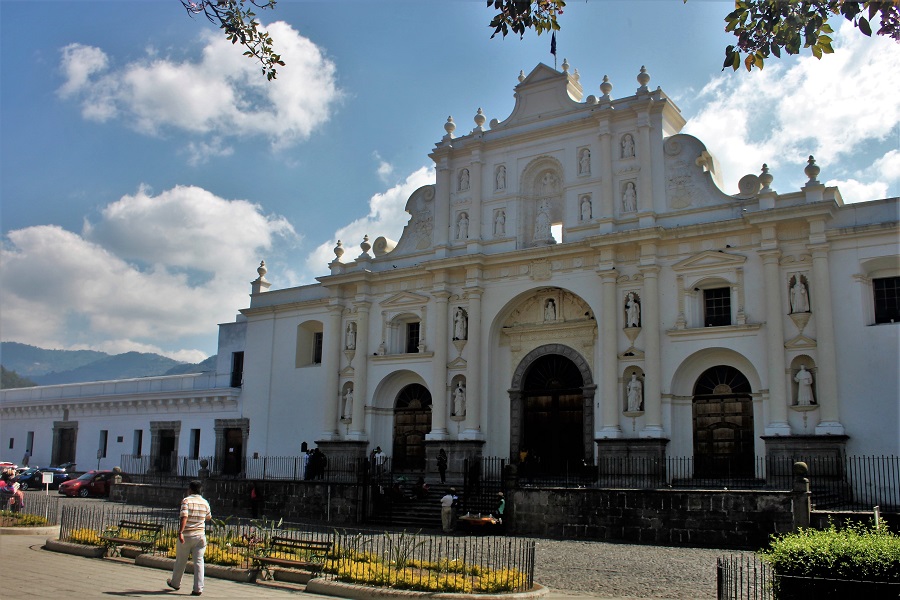
We left the square by the South Eastern corner where we saw for the first time the front of the 16th century Catedral de San Jose. It was completely destroyed in the devastating 1773 earthquake. Its facade was restored but the rest of it remains in ruins.
After a pit stop where Gabo bought some freshly squeezed orange juice from a street vendor and Helen bought a pretty looking costume jewelery from a young girl, we continued down 5a Calle Oriente.

We peered inside the courtyard of the Musuem of Colonial Art housed in what was once the University of San Carlos, the first University in Guatemala and only the fourth in the whole of the Americas. The architecture had flavours of the Moorish influences of Andalucia. No time to stop however as we continued to the corner with 3rd Avenue and walked down to Parque la Union.
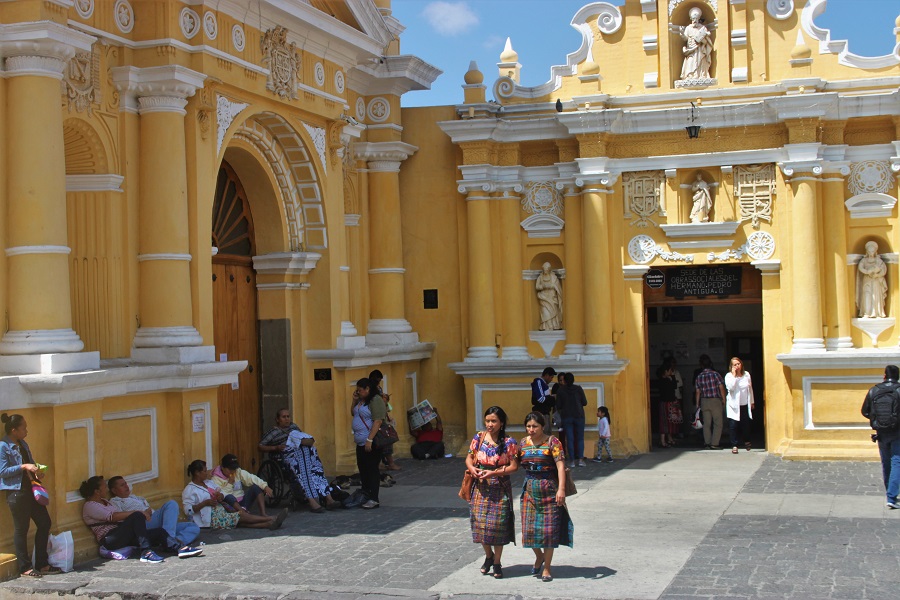
We came to the Church of San Pedro Apostol, a pretty litte church painted yellow with white flourishes like a smaller version of La Merced. To its side there was another even smaller version, this however was the entrance to Obras Sociales San Hermano Pedro, a hospital run by the church for the poor.
Gabo lead us along the length of the palm tree filled park and asked "Does anyone know how people washed their clothes in the medieval times?" Quick witted Alex replied "With a medieval washing machine?" which had us all laughing. "no, they would come to a pila, a communal wash house, and beat their clothes against a stone" he explained.
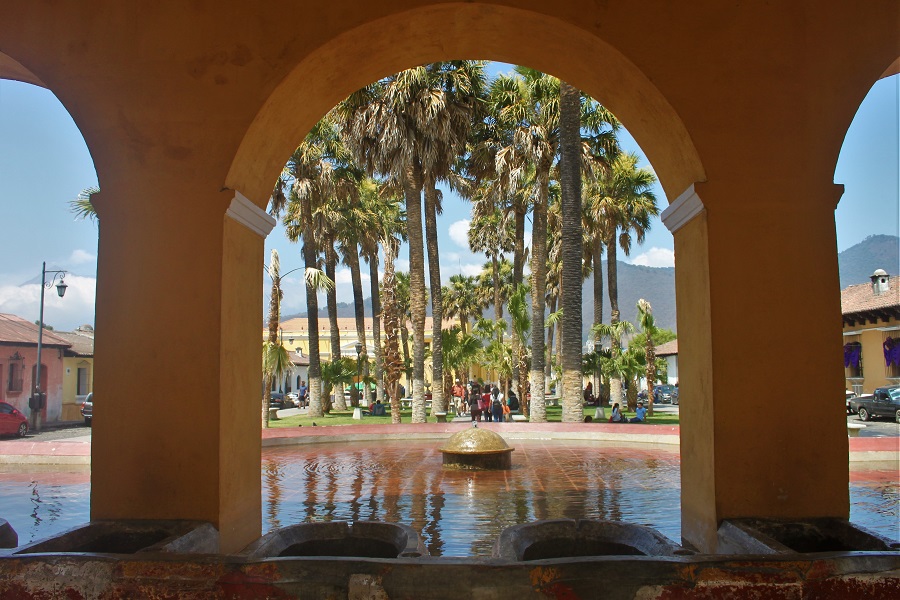
At the end of the park there was a wash house, a dozen stone basins lined up in the shade of a colonaded patio with water fed from a large pool. It was difficult to imagine but apparently it was still in use today.
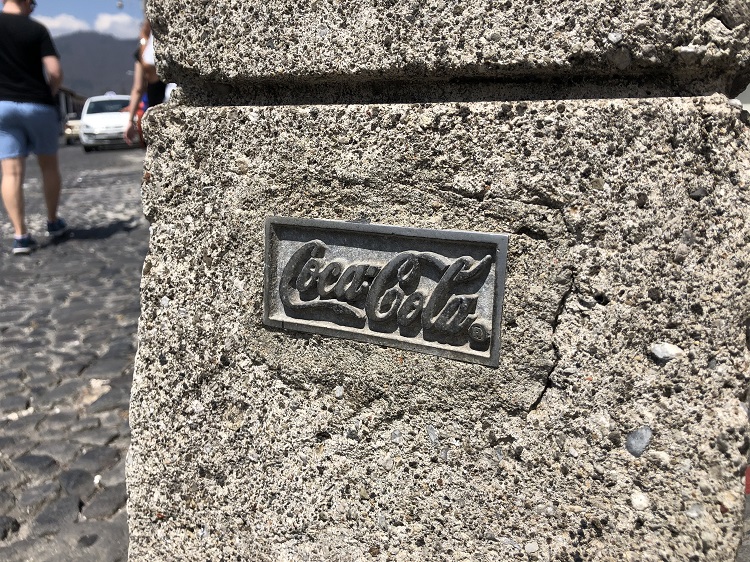
As we left the park Gabo brought to our attention again to the small Coca-Cola logos on the base of the street lamps. The large multinational company funded the street lights and wanted to put their usual red and white logo banners all over the town but that wouldn't have been in keeping with the strict town planning, so they compromised by agreeing to these very discreet logos.
Moving on we retraced out steps back up 3rd Avenue and followed Gabo into a shop called Jade.
We were greeted by a replica of the jade death mask of Pacal the Great (also known as K'inich Janaab' Pakal) the lord of the Mayan city of Palenque.
Gabo took us through into a room at the back where we were going to be given a talk about Guatemala in general, and of course the precious gemstone jade in quite some detail.
We were introduced to a guy called Robert. He was an American, and was quite eccentric, which is a polite way of saying a bit mad and more than a little wierd.
He stressed that he wasn't affiliated with owners of the store but gets paid to give these talks, especially when the cruise ships were in town. "Cruise ships?" we thought. But yes, Antigua actually is a popular day trip for cruise ships that dock on Guatemala's pacific coast.
Cruise ships is a dirty word at the moment. Recently, one called the Diamond Princess, stuck off the coast of Japan had a case of the coronavirus onboard then suddenly the entire ship was quarantined. (In the end 13 passengers died from the covid-19 virus.) Alex and Suzie are due to go on a cruise after this trip but worry it may be cancelled because of the pandemic.
Robert told us the story of Mary Lou Ridinger an archaeologist whose geologist husband Jay Ridinger convinced her that there was still jade to be found in Guatemala. He was proven right when they discovered a rich source in the Montagua valley. They went on to set up the Jade Maya business. Jade was highly prized by the Mayans who would bury their kings with jade funeral masks and other paraphenalia.
He was getting increasingly animated. His eyes seem to roll around without focus, his mind appeared to drift off before returning to the room. Alex had the audacity to ask him a question about how they drilled through a jade so hard it would "blunt a diamond blade". He completey side stepped it like a slippery politician and continued talking about some $20 million jade necklace.
He did get my attention however when he began to talk about the Mayan temples of Tikal and then described a recent visit to a site right in the very North of the Peten region, where enveloped in jungle you will find a great pyramid that would dwarf anything in the region. El Mirador is a sight waiting to be unveiled. He talked with great deal of excitement, his eyes darting about, hands waving theatrically.
After his peculiar lecture was over we all browsed the shop. Julie wanted to buy something small for herself. There were some stunning pieces available at some breathtaking prices.
If there was one thing I had learned was there were many colours of jade, from white to black and all the colours in between. The lavender jade was especially beautiful.
Julie found a small black heart pendant for $25. It came without a chain but was presented in a box, in a colourful cloth bag. Looking at the prices of many of the other items our budget got away very lightly!
Back out onto the streets we all followed Gabo back towards the Parque Central, continuing out West on a street called Poniente, which literally means West.

We walked past the severely damaged facade of the Jesuit Church Compañía de Jesús with its out of kilter columns and a fracture above the main door. There was something beautiful about its fragile state. It looked one quake away from collapse.
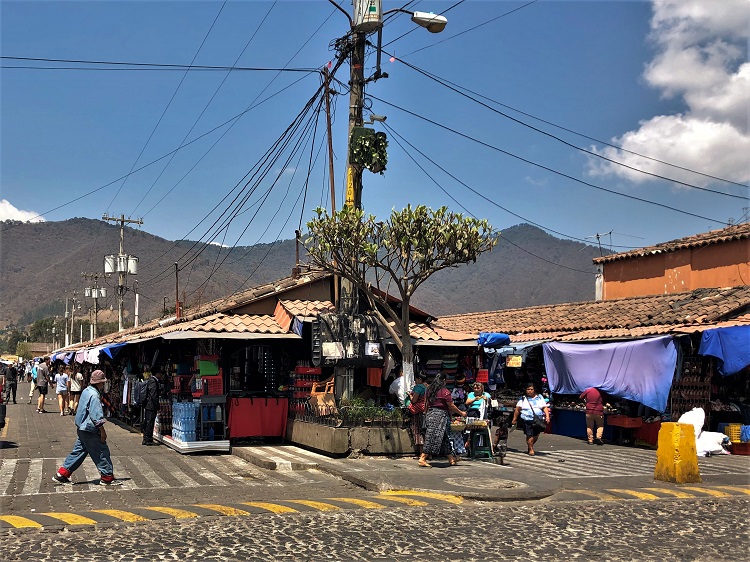
At the end of the street Poniente we arrived at the local markets. They're always fascinating places to visit.
This was the end of our orientation tour of Antigua. As Gabo made arrangements for supper this evening we made our excuses and explained we had a reservation at Hector's (which technically was not true but it was our intention). We felt a little bit embarrassed not going along with the group, but Gabo was perfectly cool about it.
So we all went our separate ways.

We delved headlong into the souk-like warren of market stalls beneath a covered area. It was so oppressive inside and it got even more so when the power supply went! Our eyes struggled to adjust to the darkness as we continued to walk blindly deeper inside.
"We need to get out, before we get lost!" said Julie. She was right. It was getting increasingly disorientating.
Eventually we saw a chink of daylight near a sombrero store and before we knew it we were back outside in the bright sunshine. From then on we stayed on the outside of the market.

Around the back of the markets was the bus station where all the local chicken buses from all over the region arrived. The air may have been thick with diesel fumes but it was such an exciting experience to walk amongst the colourful coaches listening to the drivers call out for passengers, chirping like the mating call of the quetzal. (Guatemala's national bird)
We almost got on one to Chimaltenango but we chickened out, (pardon the pun). Not only do the chicken buses have a bad reputation for being rammed full of people (and livestock) which would have been interesting, but they drive across mountain roads with precipitous drops at breakneck speeds and faulty brakes. Many have ended up at the bottom of a deep ravine.
From the end of the bus station we walked back towards town, through an open air fruit & veg market which was more like what we wanted to see, the vibrant daily life of locals picking up their fresh groceries.

Happy, having seen scenes of exotic fruit and women in traditional Huipiles, we left the marketplace and walked back into town, heading East down West street.

Earlier Gabo had mentioned that we had just walked past a McDonalds. It was so discreet we hadn't even noticed it. "It's probably the prettiest McDonalds in the world!" he said with a cheeky smile.
So, as we were passing on our way back we went inside to have a look for ourselves and yes it was very pretty. It had a lovely patio area and open courtyard, with a fountain in the middle. However it still served fast food crap and eventhough we were thinking about lunch we didn't bother looking at the menu. Although in hindsight if they did a veggie McTaco I may have been tempted!
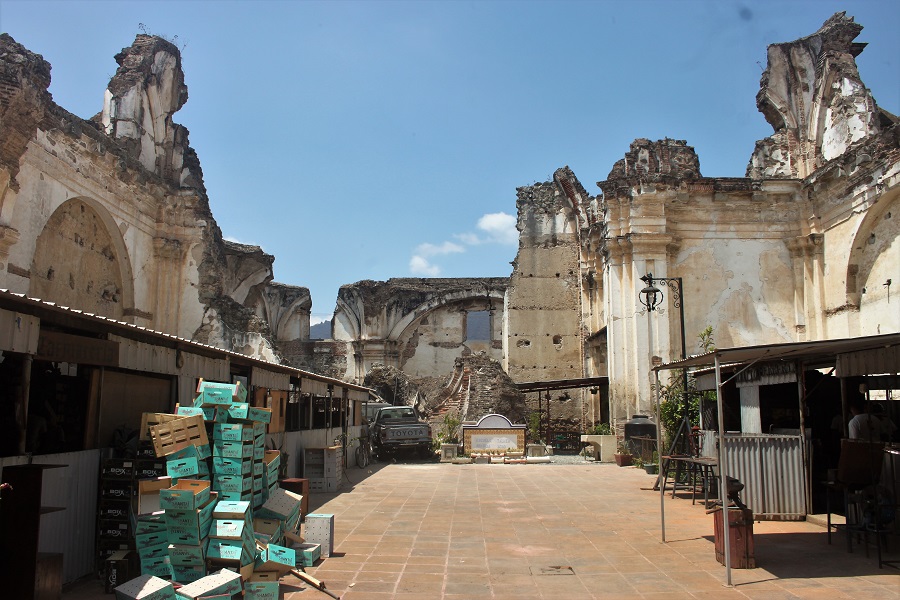
A little further along we came back to the ruined church of Compañía de Jesús, and spotted an open door, or an open invitation (as I put it) to walk inside. The crumbling interior was filled with units made from corrugated iron sheets which small businesses could rent. One seemed to be a welder another a wholesaler of a kind, there even appeared to be a small bar with stools to sit. Julie didn't feel at ease inside somewhere where the walls could topple over with the slightest gust of wind, so we didn't hang around.

It was now time for lunch and we came across a little cafe called Chermol. It looked really funky and their menu had several empanadas that caught my eye but we were left disappointed. The food wasn't ready! I had a coffee and Julie had what suspiciously looked like tap water (although I'm sure it was filtered) She didn't want to take any chances of getting an upset stomach so she poured it into a plant box! We paid our bill and made a sharp exit.
After stopping again at a coffee shop on the corner of Parque Central we checked out restaurants in our vicinity then continued walking East along West street until we reached one called Tartines.
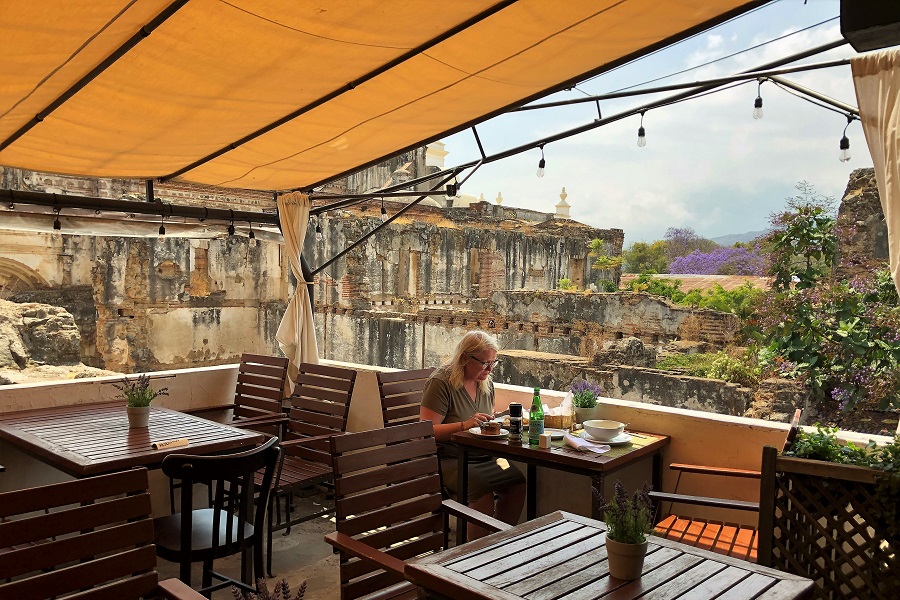
They directed us up a rickety spiral staricase to their rooftop dining area which had an amazing view overlooking the cathedral ruins. It was a wonderful back drop for lunch.
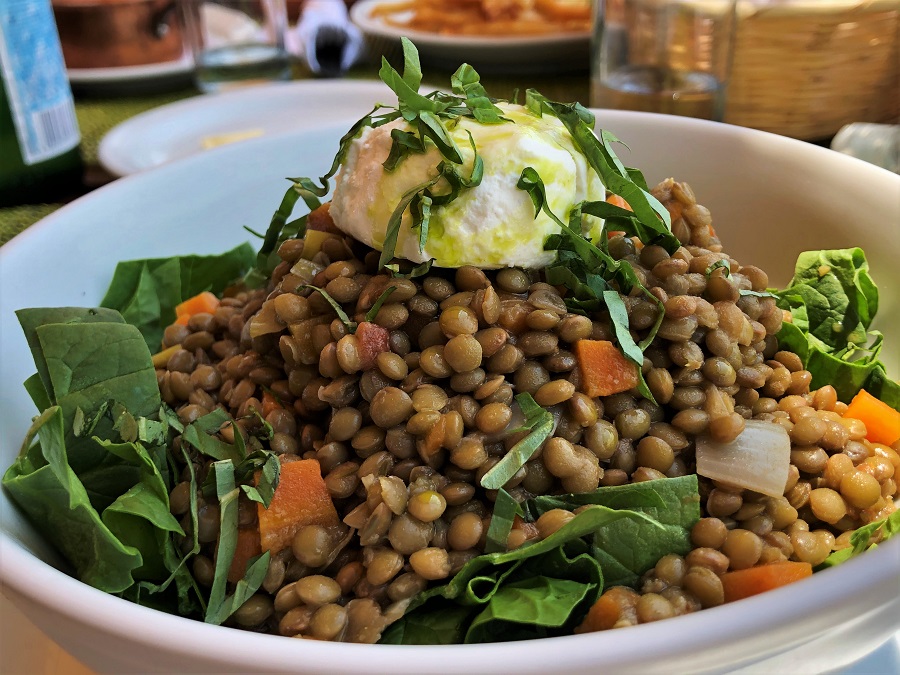
The menu had a strong French influence, which usually for a vegetarian means omelette but that was not the case here. I had a goats cheese and lentil salad which was delicious. Julie went for a chicken fillet and french fries which may sound boring but the garlic and rosemary aroma coming from her plate was incredible.
Full and satisfied we returned to our hotel, (via Hectors to book our table for this evening) and settled in for a little siesta.
Before having a nap we checked the news back home. After the global pandemic annoucement from WHO on Wednesday the UK government haven't introduced any restrictions but have been making noises that some announcement is imminent. A total of eleven people have died from coronavirus in the UK, it's now 5000 globally. Boris Johnson warns that "many families will lose loved ones before their time".
In the meantime the Premier League have decided to postpone all games until the 3rd April. I've not read the word unprecedented so much in my life before!

After my forty winks I got up to walk up Cerro de la Cruz, (the hill of the cross). Julie was quite happy to stay in siesta mode. As I was leaving the hotel I bumped into Gabo who suggested a shorter route along the road that skirts the old town. It wasn't the most pleasant of walks as the road was busier than any other street. The increase in exhaust fumes was particularly noticable.

At the end of the street I came to the junction with 1a Avenida Norte where across the road, just beyond a kids playground was another striking ruined church known as Colonia Candelaria. There was hardly any of it left but it was beautiful.
From here the gradual climb up the hill began, first along the road, then on the bend I came to the steps that lead up to the viewpoint.
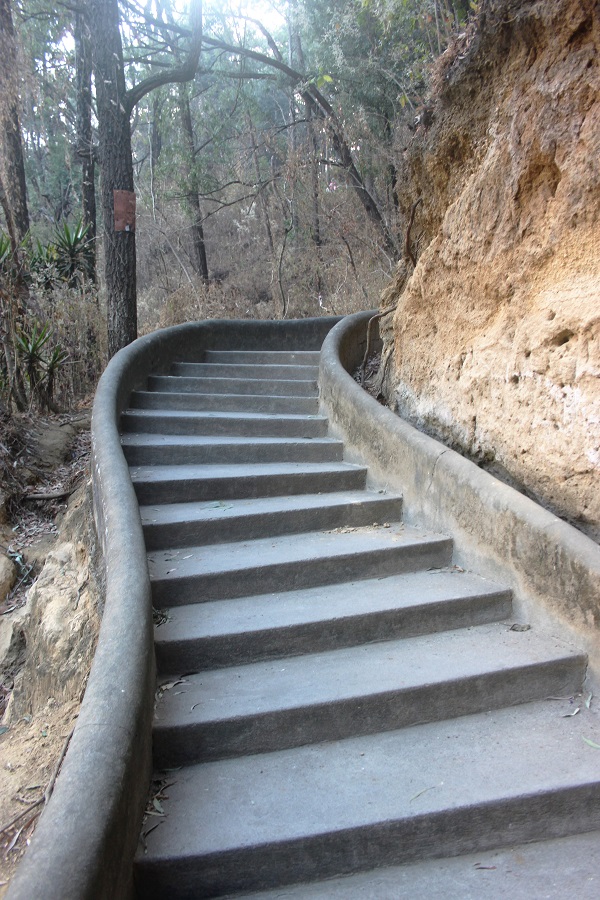
It was very well maintained path and not too steep. I began the walk with a spring in my step but it wasn't long before I was huffing and puffing. I took that as a good sign that my lungs were working well and that my stroll down fume-filled alley hadn't caused any lasting damage.
(Joking aside I had read that if you hold your breath for 20 seconds without coughing then there's no covid-19 fibrosis in there!)
Determined not to let some whipper-snapper overtake me I marched up the hill without pausing for breath.
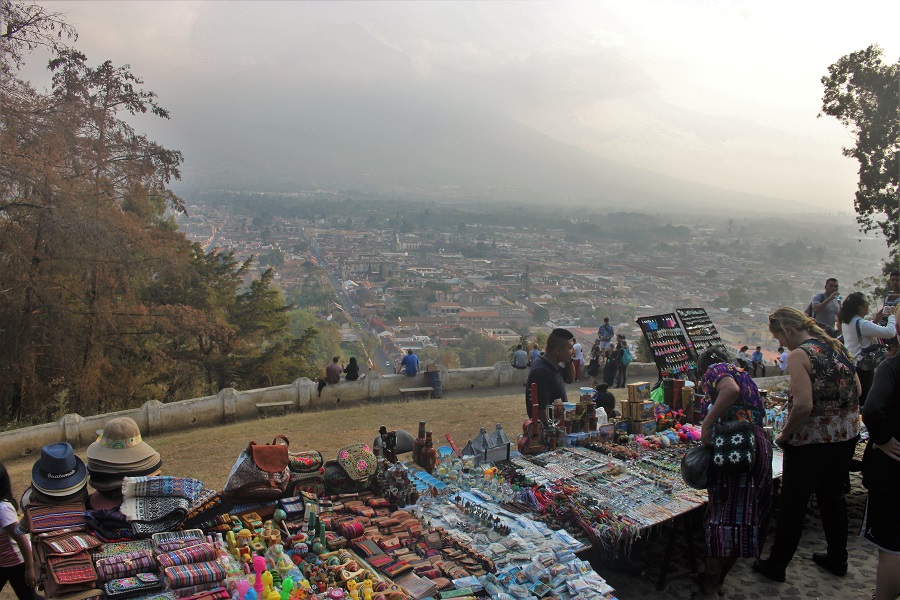
When I reached the top I needed to sit down! So I walked past the souvenir stalls, down to the permiter and joined many others sat on the wall taking in the view. I also desperately needed a drink. Fortunately I had brought a small bottle of filtered water with me from the hotel, which I sucked out in 3 seconds flat.

The weather had turned a little cloudy, which was a real shame as I could hardly see the Volcan de Agua on the other side of the valley. Antigua's colonial spleandour sprawled beneath me in the haze. As the sun was setting, it was still a magical sight.
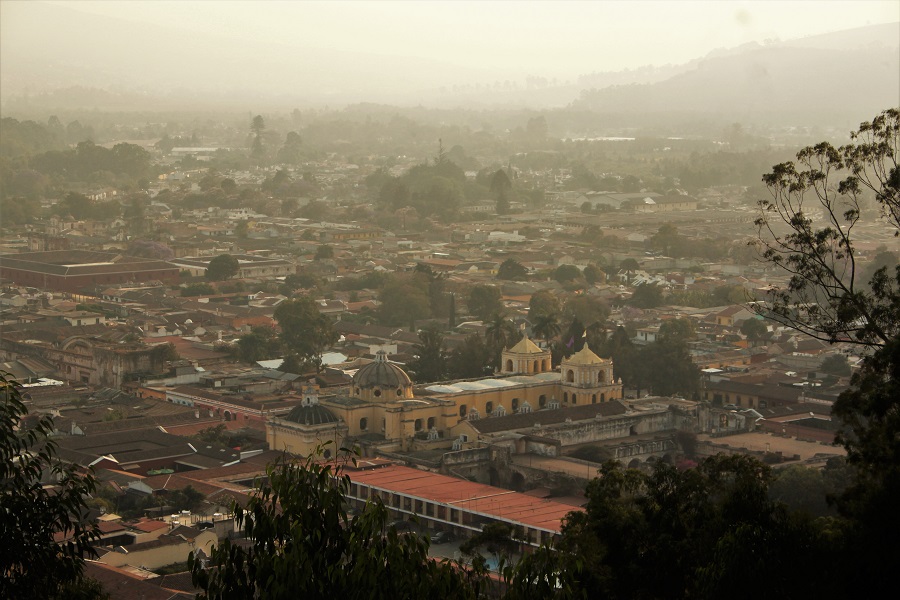
I spent a few minutes trying to find familiar landmarks like Parque Central, Arco di Santa Catalina and Iglesia La Merced which rose above the rooftops. This also allowed time for my heartbeat to return back to something near normal.
It seemed a bit clearer in the direction of Volcan de Fuego, which was good for five of the group who had gone hiking up the erupting volcano this afternoon.
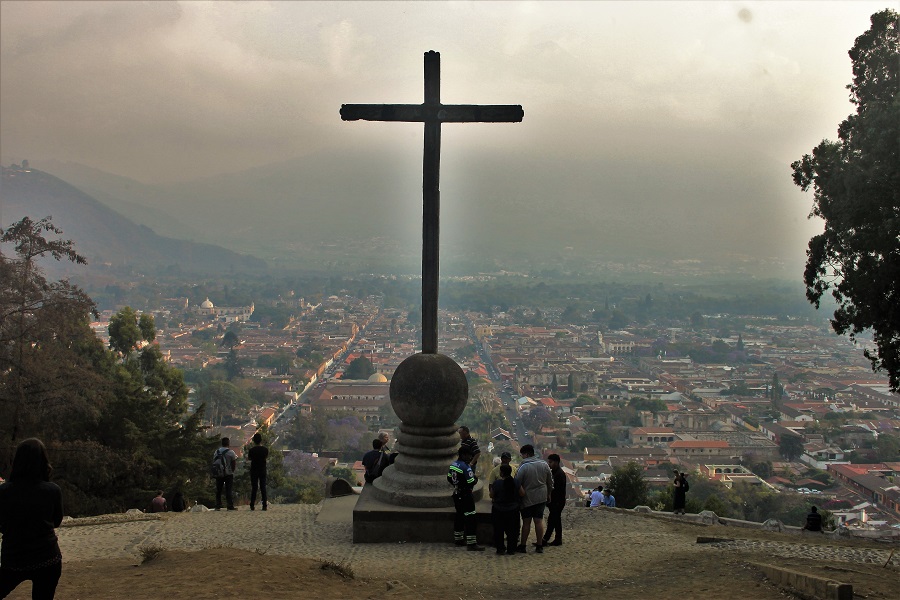
With my composure regained I walked further up the hill to get a better view of la Cruz, a cement cross put here in 1930 and is dedicated to the city's patron saint, Sant Iago (St. James). When the city was the capital of Guatemala it was known as Santiago de los Caballeros de Guatemala, (St.James of the Knights of Guatemala)
This area in the past had a bad reputation for muggings but today it's far more of a family affar. Having said that there was still a few tourist police officers about to deter those desperate enough to steal.
It was time to leave, so back down the steps I went, which was a lot easier on the lungs than the ascent. Back down in town I decided to take the more scenic route rather that fume filled shortcut. It actually wasn't that much further.

Our reservation at Hector's was 8pm but we arrived a bit early hoping our table was ready and it was! We started the evening with a margarita, served in traditional margarita glasses. They tasted wonderful, the right balance between refreshing and alcoholic.
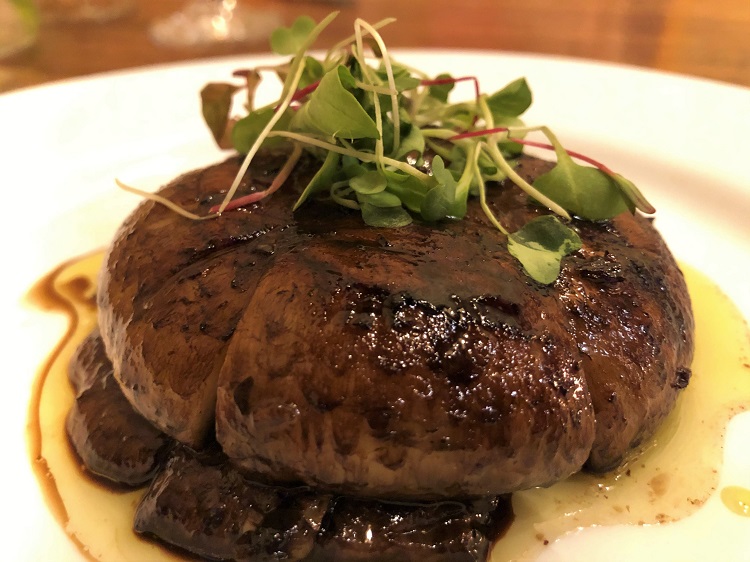
The food was as good if not better than our first meal here. My dish was absolutely sensational. The Portabello Mushrooms, roasted and seasoned with balsamic vinegar and olive oil was simply incredible. This was cooking of the highest level. I also had a side dish of slow roasted tomatoes with gouda cheese which worked so well together.
Julie, after quite some umming and ahing went for the same dish as our first evening, the surf and turf and was not disapponted. It turned out to be the perfect culinary evening.
With a 4am start tomorrow we decided not to have a repeat of last night's shenanigans and headed back to Casa Florencia. Our bags were already packed this afternoon so the moment we were in our room it was lights out and an early night.
Next day >